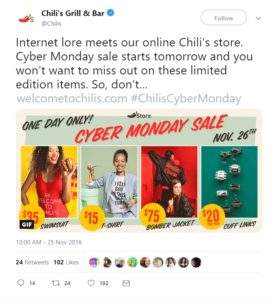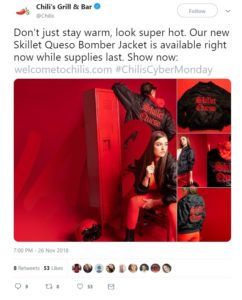
There was a lot of speculation surrounding this shopping season, and Black Friday and Cyber Monday did not disappoint. According to Adobe Analytics, Black Friday brought in $6.22 billion in online sales and Cyber Monday grossed $7.9 billion, making Cyber Monday the biggest online shopping day in U.S. history. Now that the sales have ended, we’re analyzing Black Friday/Cyber Monday strategies and how they can be applied year round.
Geotargeted Email Marketing
We give DSW our mark of approval for perfectly blending geotargeting and email marketing. There is some controversy over whether hypertargeting consumers is considered “creepy”; however, DSW found a balance by offering recommendations on footwear based on weather forecasts from subscribers’ cities, a great way for the brand to drive seasonal sales. This strategy may appear simple, but it makes consumers think proactively about the upcoming season in a high impact way. Another pro: whether or not consumers decide to purchase, brands can track open and click activity to better understand consumer preferences and personalize communications. Because the data is owned, brands can continue to build more detailed consumer profiles. This tactic can be particularly helpful for newer brands still trying to define their target markets. Tracking behavior (even during sales periods) can help tailor emails, ads, and other omnichannel marketing tactics year round. DSW’s strategy of city-based marketing can also be applied to local sales, store-specific sales, exclusives, and more.
Online Pop-Ups
Pop-ups are trending this holiday season. From the unexpected, rebranded comeback of Geoffrey’s Toy Box (aka Toys ‘R’ Us) to Amazon, retailers in the U.S. and abroad have considered these short-lived retail spaces as a new, fiscally sound way to engage their customers. Chili’s took it a step further by creating an online pop-up, trendjacking their own pop culture references. Selling everything from jackets to swimsuits, the restaurant chain sold limited products on www.WelcometoChilis.com. They promoted these products by uploading teaser posts to social media channels for their Cyber Monday exclusive sale.
 Their strategy of trendjacking isn’t uncommon, especially for fast food chains and restaurants on social media, but making branded products that diverge from their typical offerings took it beyond the bounds of Chili’s normal activity. There’s no doubt the brand was targeting a niche, younger audience. Could this be a proactive step to stem younger generations’ decline in preference for chain restaurants?
Their strategy of trendjacking isn’t uncommon, especially for fast food chains and restaurants on social media, but making branded products that diverge from their typical offerings took it beyond the bounds of Chili’s normal activity. There’s no doubt the brand was targeting a niche, younger audience. Could this be a proactive step to stem younger generations’ decline in preference for chain restaurants?
 As online shopping continues to proliferate and companies inside and outside the retail space rethink what it means to have brick and mortar stores, physical and virtual pop-ups will continue to trend. They not only help retailers cut costs but also allow retailers to surprise and delight their audiences. They are a pervasive way to test what your target market wants and to explore new revenue streams, whether it is during the holiday season or throughout the year.
As online shopping continues to proliferate and companies inside and outside the retail space rethink what it means to have brick and mortar stores, physical and virtual pop-ups will continue to trend. They not only help retailers cut costs but also allow retailers to surprise and delight their audiences. They are a pervasive way to test what your target market wants and to explore new revenue streams, whether it is during the holiday season or throughout the year.
Did we miss anything? What were the marketing experiences you enjoyed most during Black Friday/Cyber Monday?

 (
(